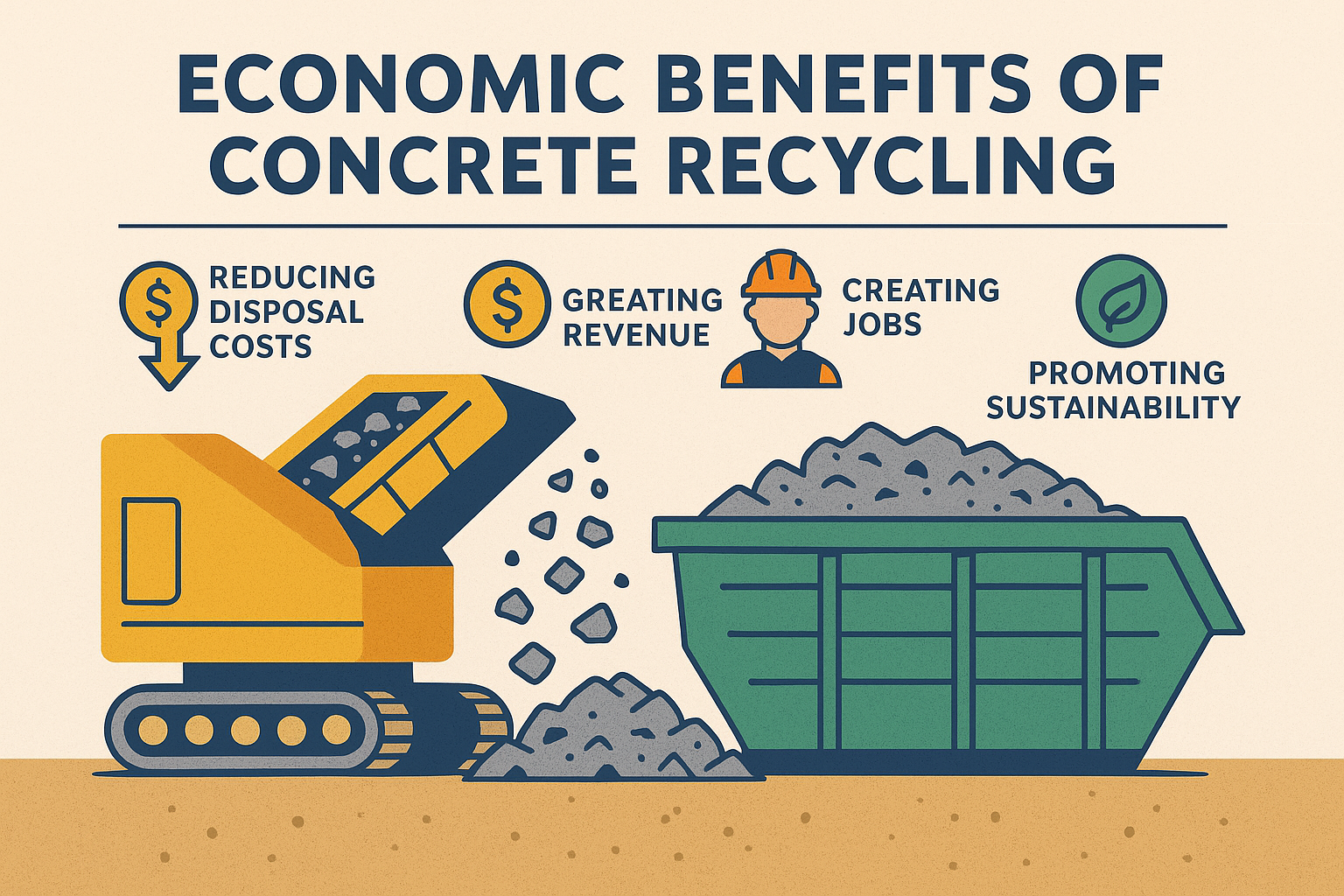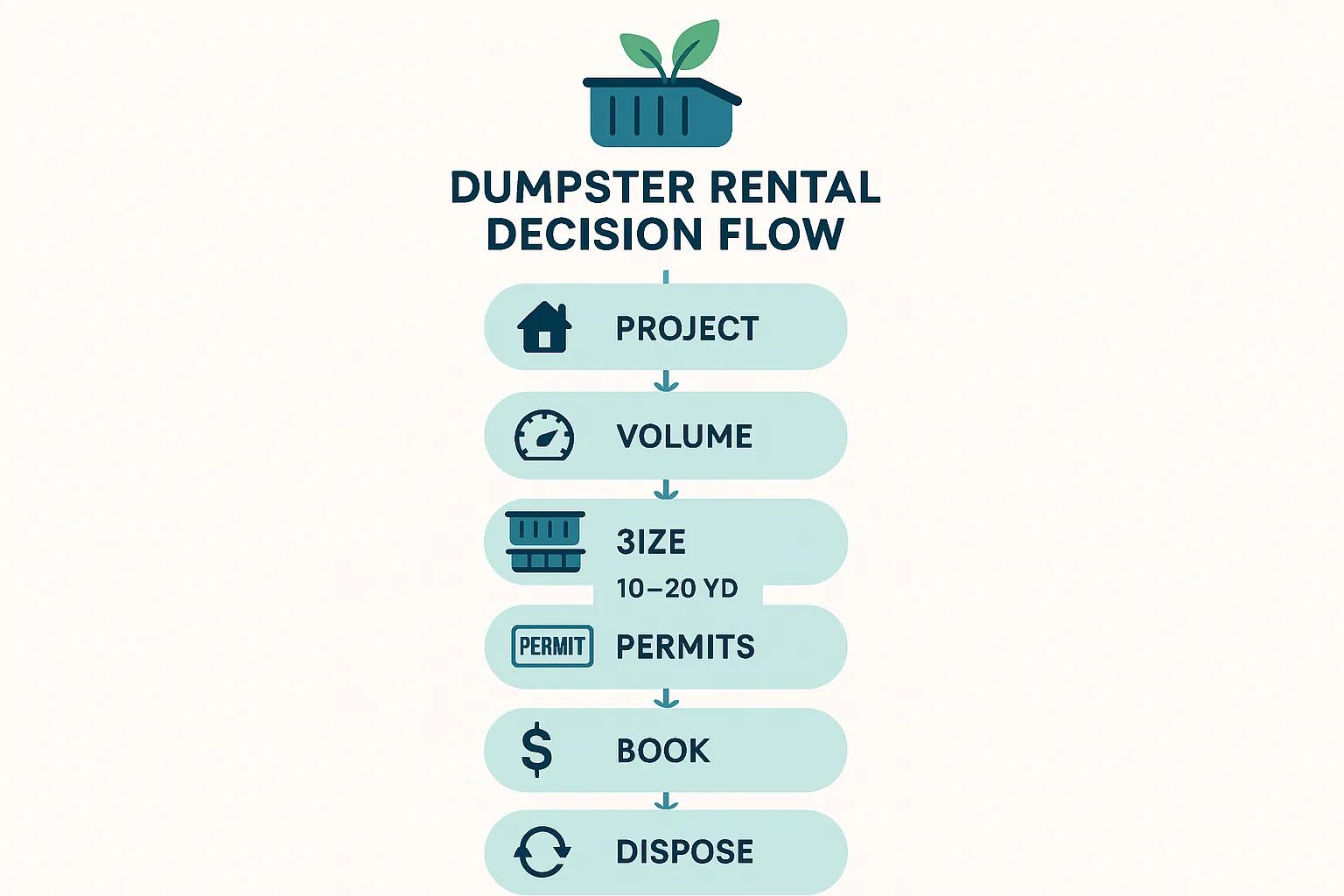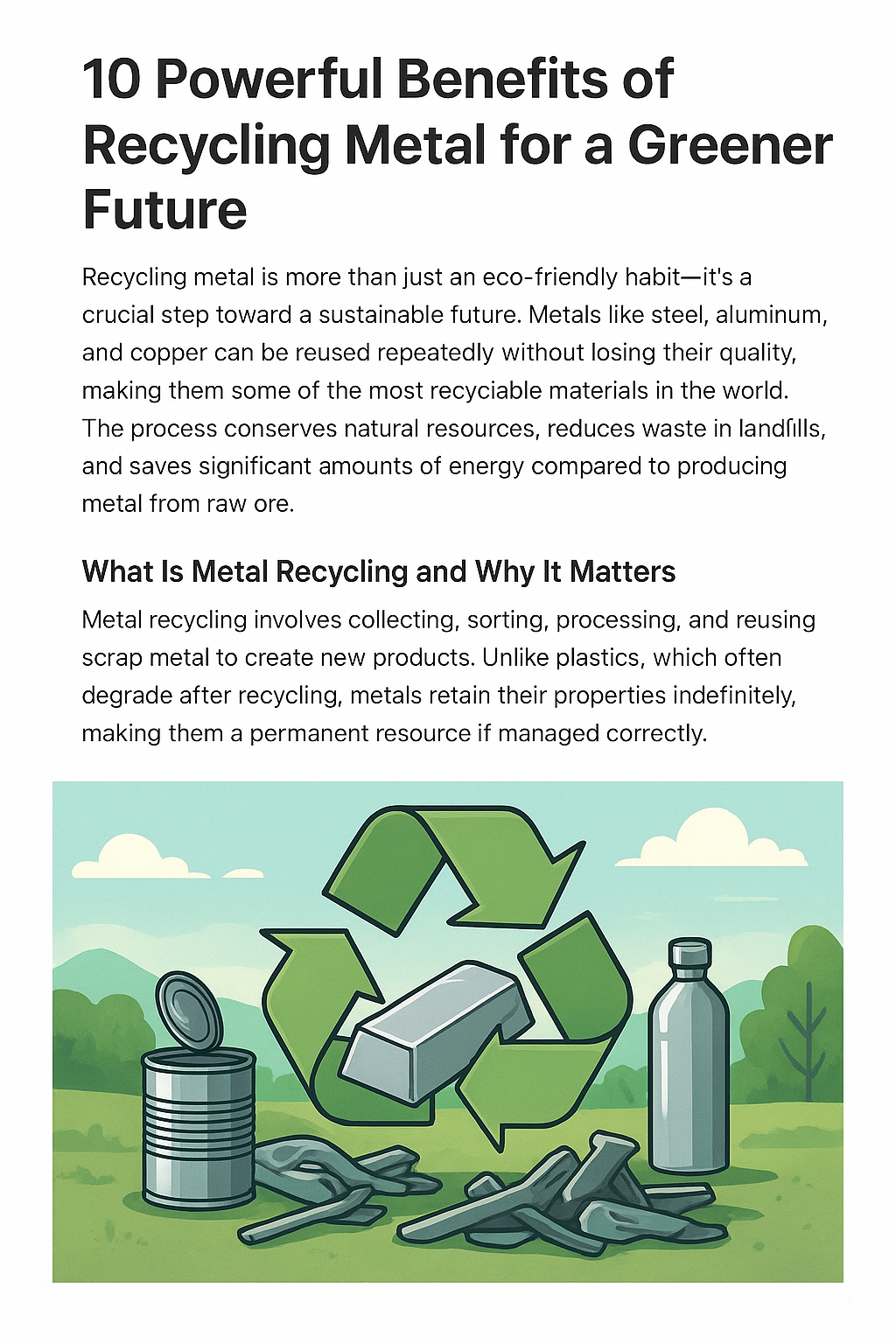
Understanding Concrete Recycling
What Is Concrete Recycling?
Concrete recycling is the process of reclaiming concrete debris from demolition or construction projects and converting it into usable materials. Instead of sending concrete waste to landfills, it’s crushed, screened, and repurposed as aggregate or base material for new construction.
The Lifecycle of Concrete Waste
Concrete waste typically comes from:
-
Demolished buildings and sidewalks
-
Old foundations or parking lots
-
Surplus material from construction sites
Once collected, it’s sorted, cleaned, and processed. Recycled concrete is often used in road bases, retaining walls, landscaping, or even as a component in new concrete mixes.
How Concrete Is Reprocessed
Recycling facilities use crushers, screeners, and magnets to:
-
Break down large chunks
-
Separate rebar and contaminants
-
Sort the crushed material by size
What was once trash becomes a valuable product ready for reuse.
Why Concrete Waste Is a Growing Problem
Volume of Construction Waste
The construction industry generates hundreds of millions of tons of waste annually—concrete makes up a significant portion. Left unmanaged, this volume puts serious strain on landfills and budgets.
Landfill Pressure and Environmental Risks
Dumping concrete:
-
Takes up significant space in landfills
-
Increases tipping fees
-
Releases carbon dioxide through transport and decomposition of associated materials
Concrete recycling helps reduce this pressure while keeping cities cleaner and more efficient.
Traditional Disposal Costs
Sending concrete to a landfill involves:
-
Loading and transport costs
-
Tipping fees (often charged per ton)
-
Labor for handling and sorting
These costs can add up quickly for contractors and municipalities managing large-scale projects.
Economic Advantages of Concrete Recycling
Reduced Hauling and Disposal Costs
Recycling concrete on or near a job site:
-
Cuts transportation costs
-
Avoids long hauls to distant landfills
-
Lowers dump fees
Contractors can also reduce the number of dumpsters needed for mixed waste, which simplifies waste management.
Lower Fees for Landfill Tipping
Many landfills charge up to $100 per ton for construction debris. By diverting concrete, businesses can dramatically cut disposal expenses.
Cost Savings for Contractors and Municipalities
Cities and builders that implement recycling practices:
-
Spend less on materials (using recycled base)
-
Save on hauling and landfill fees
-
Avoid fines for improper waste separation
Every recycled ton means more savings and less waste.
Revenue Opportunities Through Recycled Materials
Selling Recycled Aggregate
Recycled concrete aggregate (RCA) has real market value. Contractors or recyclers can sell it to:
-
Road builders
-
Landscaping companies
-
Precast concrete manufacturers
Instead of paying to get rid of debris, businesses can turn concrete waste into a revenue stream.
Partnering with Local Construction Firms
Some companies specialize in buying or trading recycled material. Strategic partnerships create:
-
Steady demand for recycled products
-
Local economic development
-
Reduced need for importing raw aggregates
Creating a Circular Economy Model
When concrete is reused locally, businesses help build a circular economy—where waste becomes a resource, reducing dependence on extraction and boosting regional supply chains.
Job Creation in the Recycling Industry
Skilled and Entry-Level Jobs
Concrete recycling supports job creation in:
-
Material handling
-
Crushing and screening operations
-
Transportation and logistics
From machine operators to quality control inspectors, this sector offers a wide range of employment opportunities.
Equipment Operation and Maintenance Roles
As demand for recycling grows, so does the need for:
-
Loader and crusher operators
-
Mechanics
-
Plant technicians
Many of these jobs pay well and offer long-term career potential.
Community Economic Growth
Establishing concrete recycling centers can revitalize:
-
Industrial zones
-
Underserved neighborhoods
-
Local construction industries
Recycling not only reduces waste—it helps communities thrive.
Role of Dumpsters and Waste Separation in Efficient Recycling
Using Dedicated Dumpsters for Concrete
To effectively recycle concrete, construction sites should use dedicated dumpsters specifically for concrete and masonry waste. This keeps materials clean and uncontaminated—making recycling faster, easier, and more profitable.
Providers like National Waste offer heavy-duty roll-off dumpsters designed to handle the weight and volume of concrete. These specialized containers:
-
Prevent damage to pavement or property
-
Allow for efficient sorting and removal
-
Are sized to match different project scopes (10-yard, 20-yard, etc.)
Training Crews for Waste Separation
One of the most cost-effective ways to boost concrete recycling is by training workers on proper waste separation. Clear guidelines ensure that:
-
Recyclables aren’t mixed with landfill-bound waste
-
Dumpsters are used correctly
-
Material contamination is minimized
Educated crews help reduce errors that cost time and money later in the process.
Supporting Higher Recycling Yields
Proper separation leads to:
-
Better quality recycled aggregate
-
Lower processing costs
-
Higher overall diversion rates
It’s not just about being sustainable—it’s about improving the bottom line while reducing the footprint.
National Waste and Commercial Recycling Services
Concrete Dumpster Rentals
National Waste offers commercial-grade dumpsters tailored to the demands of the construction and demolition industry. Their concrete dumpsters:
-
Are designed for dense materials
-
Come in multiple sizes
-
Include scheduled or on-demand pickup options
On-Site Sorting and Pickup
In addition to dumpster services, National Waste supports on-site waste management with:
-
Custom waste sorting solutions
-
Regular site visits and pickups
-
Documentation for compliance and reporting
Their goal is to simplify waste diversion while increasing cost efficiency for contractors.
Reporting and Sustainability Support
For companies pursuing green building certifications or public reporting, National Waste provides:
-
Monthly or quarterly diversion reports
-
Waste tracking dashboards
-
Support with LEED documentation
This makes it easier for builders to meet sustainability goals while saving money.
Waste Diversion and Landfill Avoidance
Metrics for Measuring Diversion
Diversion rates are calculated by measuring:
-
Total waste generated
-
Weight or volume diverted through recycling
-
Percentage sent to landfill
Tracking this data helps contractors evaluate environmental impact and optimize dumpster usage.
Long-Term Cost Benefits
Over time, reducing landfill use lowers:
-
Cumulative disposal fees
-
Transportation costs
-
Regulatory risk (especially in states with zero-waste mandates)
Investing in concrete recycling today means compounding savings tomorrow.
Aligning with Sustainability Goals
Governments and corporations alike are moving toward sustainability targets. Concrete recycling supports:
-
Net-zero emissions plans
-
Local economic development
-
Environmental leadership in the industry
Recycling isn’t just good business—it’s good branding.
Sustainability Meets Profitability
Eco-Friendly Branding and Consumer Trust
Today’s customers care about sustainability. Contractors that use recycled materials and minimize waste:
-
Attract eco-conscious clients
-
Stand out in competitive bids
-
Build trust with partners and stakeholders
“Green” is no longer a buzzword—it’s a differentiator.
Incentives and Government Grants
Many regions offer:
-
Tax credits
-
Rebates
-
Grants
…for companies investing in recycling equipment, using sustainable materials, or diverting construction waste. Staying informed can unlock substantial savings.
Earning Points for LEED or Green Building Certifications
LEED (Leadership in Energy and Environmental Design) awards points for:
-
Using recycled content
-
Diverting waste from landfills
-
Tracking waste data
Projects that meet these criteria enjoy:
-
Faster approvals
-
Reduced utility bills
-
Higher property values
Cost Comparison: Disposal vs. Recycling
Disposal Costs Per Ton
Dumping concrete in a landfill isn’t cheap. Costs include:
-
Tipping fees: $50–$100 per ton depending on location
-
Transport costs: Fuel, labor, and equipment time
-
Hidden penalties: Overweight dumpsters, environmental fees, or regulatory fines
For large projects, these costs can add up to tens of thousands of dollars.
Revenue from Aggregates and Fill
On the flip side, recycled concrete aggregate (RCA) can sell for:
-
$8–$15 per ton (depending on region and quality)
-
Even more when used for specialty applications (e.g., road base, backfill)
A project that generates 1,000 tons of concrete waste could recoup $10,000 or more just by selling or reusing materials onsite.
Savings Over Large-Scale Projects
When scaled to multi-phase developments or ongoing infrastructure builds, recycling:
-
Saves 20–40% in waste handling costs
-
Reduces reliance on new raw materials
-
Avoids landfill permit issues
Simply put: the bigger the project, the bigger the savings when concrete is recycled.
Challenges and How to Overcome Them
Contamination and Sorting Issues
Mixed waste bins lead to contamination that reduces recycling value. Solutions:
-
Clearly labeled dumpsters
-
On-site recycling supervisors
-
Contractor education sessions
Proper sorting up front saves time and money later.
Initial Investment in Equipment
Starting a recycling program may require:
-
Onsite crushers or screeners
-
Training costs
-
Coordination with haulers
However, most businesses recover these costs within the first year through landfill savings and revenue.
Changing Mindsets Among Crews
Old habits die hard. Workers used to “just throw it away” may need:
-
Orientation programs
-
Incentives for proper sorting
-
Hands-on demonstrations
Culture change is key to making concrete recycling a normal part of daily operations.
Case Studies in Concrete Recycling Success
A Construction Firm Reducing Costs by 40%
A mid-sized contractor in Florida partnered with National Waste to implement onsite concrete recycling. By renting dedicated dumpsters, separating waste, and reusing RCA, they cut disposal costs by $120,000 over 18 months.
A Municipality Creating Local Jobs
A city in the Midwest opened a public-private concrete recycling center. Within two years:
-
12 full-time jobs were created
-
Over 25,000 tons of material was diverted from the landfill
-
Local contractors began purchasing recycled aggregate at lower costs
National Waste Partnering with Developers
In several multi-phase developments, National Waste has provided full-service concrete recycling support—including dumpsters, pickup, and sustainability reporting. Developers met their LEED requirements while reducing costs and time on waste logistics.
Frequently Asked Questions About Concrete Recycling
Q1: Is recycled concrete as strong as new concrete?
Yes, for many applications like road base, drainage layers, and backfill. It’s not typically used for structural concrete but performs well in most construction roles.
Q2: Can concrete be recycled on-site?
Absolutely. Portable crushers allow you to process waste directly on your site, reducing transport costs and speeding up project timelines.
Q3: What equipment is needed for recycling?
You may need:
-
Jaw or impact crushers
-
Screens
-
Loaders and conveyors
Or you can hire a third-party service like National Waste to handle it all.
Q4: Are there regulations for concrete recycling?
Some cities require documentation for recycling practices, especially on public projects. Check local ordinances for diversion mandates or green building codes.
Q5: How do dumpsters help separate concrete?
Designated dumpsters for concrete prevent contamination with general waste, making the recycling process more efficient and the recovered material more valuable.
Q6: Is recycling concrete profitable?
Yes—when done properly, it cuts costs and generates revenue through aggregate resale and reduced landfill fees.
Conclusion: Smart Waste Management Starts with Concrete Recycling
Concrete recycling is more than a trend—it’s a smart financial decision that helps the environment and boosts your bottom line. Whether you’re a contractor managing a demo site or a city planner building green infrastructure, concrete recycling offers:
-
Lower disposal costs
-
Increased job opportunities
-
New revenue from recovered materials
-
Better compliance with environmental standards
With tools like dedicated dumpsters, clear waste separation, and support from providers like National Waste, it’s easier than ever to implement concrete recycling into your waste management strategy.
Recycle smarter. Build greener. Save more.



